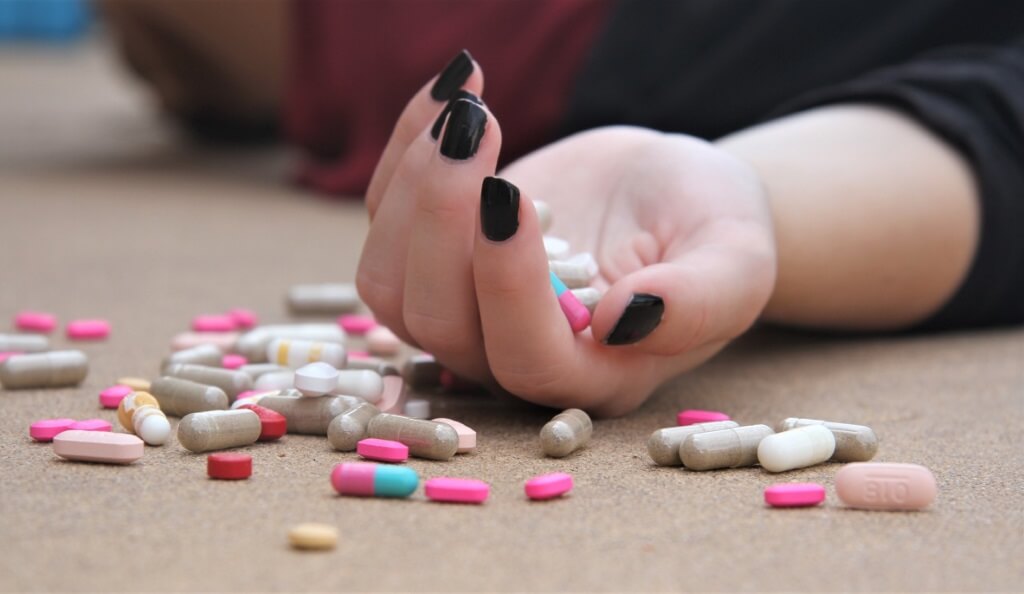Last updated on June 10th, 2024 at 10:52 pm
As drug addiction in Bangladesh is about to go uncontrolled with various types of drug abuses, especially yaba (Methamphetamine), the government of the country has declared the ‘War against the drugs’ which causes numerous criticisms and Prime Minister Sheikh Hasina has been condemned for the same reason Duterte was lauded.
The editorial piece of The Daily Independent duly noted that “of the drugs the most popular among the addicts nowadays in Bangladesh is yaba and alarmingly, over the past six years, its use has increased by 77 times in the country. This yaba is destroying the young generation and the substance is now easily available everywhere in the country”.1 With 800,000 pieces of consumption daily, it is responsible for many criminal activities. Drug addiction in Bangladesh is next to an unbridled phenomenon. People related in narcotic control estimate that users across the country consume BTD 200 million worth of drugs daily, 73 billion a year. A report estimates that there 20 million drug users in Bangladesh.
The common drugs and drug statistics in Bangladesh
As per United Nations’ World Drug Report 2021, in 2019 around 275 million people used drugs, a 22 per cent increase from 2010. 13 per cent or about 36.3 million people who use drugs were found to suffer from drug disorder. Nevertheless, by 2030 the number of the people using drugs will rise by 11 per cent across the globe, especially in low-income countries.
Cannabis remains by far the most commonly used and cultivated drug worldwide, there were an estimated 200 million past year users of cannabis in 2019, corresponding to 4.0 percent of the global population aged 15–64. The number of cannabis users has increased by nearly 18 per cent over the past decade. 1,395 tons of resins and 3,779 tons of cannabis herbs were seized in 2019. Authorities reported some 21,000 ha under cannabis cultivation in 2019.
An estimated 20 million people used cocaine in 2019, corresponding to 0.4 per cent of the global population. 1,784 tons of cocaine produce were produced in 2019. A record high amount of 1,436 tons of cocaine were seized in 2019. 234,200 hectares of production record of cocaine was recorded in 2109.
In 2019, 62 million people were estimated to have used opioids (i.e., opiates and pharmaceutical and/or synthetic opioids) for non-medical reasons at the global level.
Use of amphetamines, in particular of methamphetamine is increasing. 0.5 per cent of global population amounting to an estimated 27 million people were found to be used it, while nearly 20 million people globally are estimated to have used “ecstasy” in 2019. 325 tons of methamphetamine, 79 tons of amphetamine, 16 tons of ‘ecstasy’ and 36 tons of other ATS (amphetamine-type-stimulant) drugs were seized in 2019 totalling 456 tons globally.
The manufacture of ATS continues to be dominated by methamphetamine at the global level. In the period 2015– 2019, close to 24,000 clandestine laboratories used in the manufacture of ATS were reported to have been spotted or dismantled worldwide. More than 95 per cent of them had been manufacturing methamphetamine; 2 per cent, amphetamine; 1 per cent, “ecstasy”; and the remainder other stimulants.
In Bangladesh, the commonly abused substances are Heroin, Codeine (Phensidyl) Cannabis, Buprenorphine, Tidijesic, Pethidine, Chorosh, Bhang, Yaba, Vayagra, Diazepam, Dexpotent, Expodent, Phenargon, Phenadril, Tusca, Alcohol, Cigarettes, Marijuana, Glue etc.
Currently, Yaba has become a popular and fashionable drug among the young and adolescents in Bangladesh. The most commonly used drugs were Ganja (77%), Heroin (69.3%), Yaba (62%), and Phensidyl (52%). About 60% of the drug abusers used Heroin as their first drug.3
According to a report, 300 million yaba pills enter Bangladesh to create a 35 billion worth trade while it is a 300-500 billion USD business around the globe. The Rapid Action Batallion seized 1.3 million pieces of yaba in 2020, and in 2021, till February, the Detective Branch of Bangladesh hauled 1.4 million pieces of yaba, the biggest haul. All agencies seized 53 million (53073665) pieces of yaba pills in 2021, the number was 36 million in 2020, according to Drug Report 2021 of Drug and Narcotic Control Bangladesh.
The DNC (Drug and Narcotic Control) research found 68% of respondents to be cannabis, 48.02 % of yaba users followed by heroin and other injectable drugs.
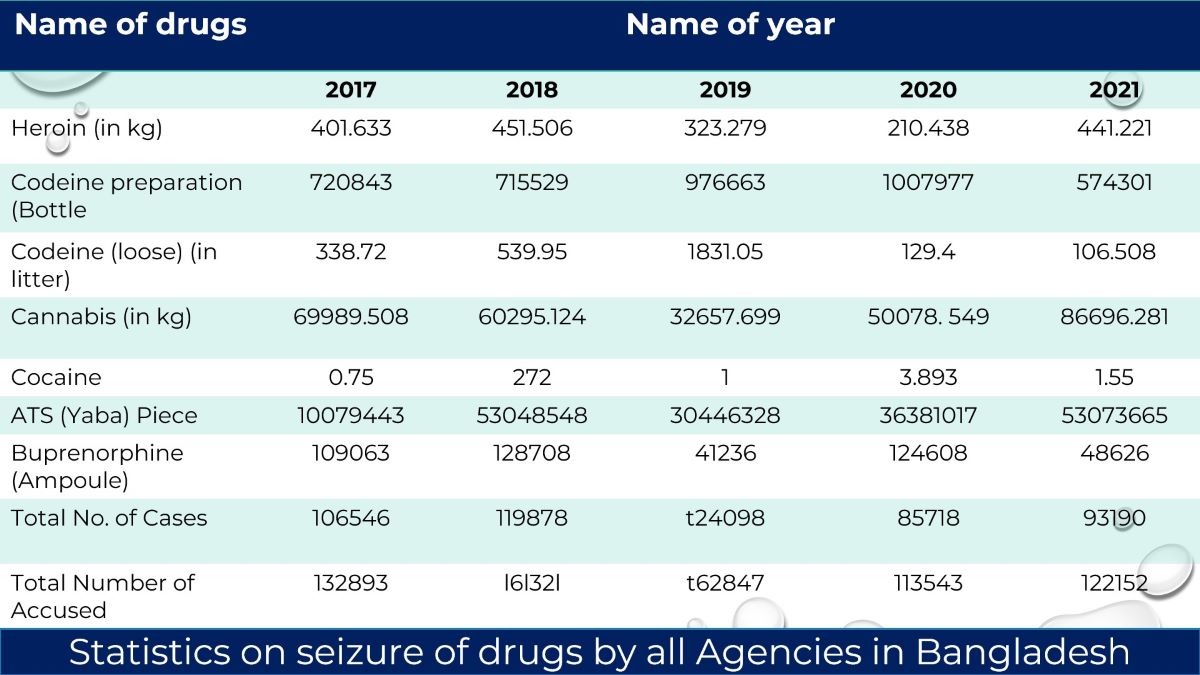
Of the available drugs, Cannabis is the most consumed drug in the Barisal division (84.8%) followed by Khulna (81.1%) and Rangpur (80.4%) while yaba is the most preferred drug in the Dhaka division (81.3%), followed by the Chattogram division (65.1%) and Mymensingh (54.9%). Heroin is the most favourite drug in Rajshahi (63.8%); followed by the Khulna division (45.6%), while Phensidyle is also the most consumed drug in the Rangpur division (53.0%) followed by the Rajshahi division (50%).4
DNC research shows yaba to be the most popular drug among youths. In this regard, respondents from Sneha Drug Treatment Centre said, “The trend of drug-use changes over time. Yaba is the most popular drug these days as it contains a high level of caffeine. The respondents from Swapno Drug Treatment Centre, Rangpur said, “Female yaba users are increasing along with males. Phensedyl is the second most popular drug”.
A top official of the Bangladesh Department of Narcotics Control, Nazrul, remarks that students of the country are the top consumers of yaba. Even though he did not present any data to support his argument, earlier this year the chairman of the parliamentary standing committee on the Home Ministry told the parliament that at least 550,000 Bangladeshi students are addicted to drugs. Of the estimated 7 million drug addicts, half of them take yaba, now the number us addict is 20 milliom. A manyfold increment in just a few years.
“Students consume yaba while lower-income people smoke marijuana and the high-income people drink alcohol”. Going by the patients admitted for treatment services, DNS found that, in 2017 and 2018, yaba is the most abused form of the drug. The distribution of yaba patients for the two consecutive years is 35.54 and 42.03 per cent.
The entrance and seizure of yaba show no sign of abatement. Every day it comes in and every day it gets seized, abusers get arrested and sued, and peddlers get killed in many cases. Retired army personnel, Major Sinha Rashed Khan, was killed on July 31, 2020, by the former OC, Pradeep, of Tekanf Police Station under Cox’s Bazar district and his accomplices. Allegedly, he was killed because of his interest in investigating the involvement of the OC and other police personnel in yaba trading.
On December 13, 2020, a Senior ASP of the Rapid Action Battalion submitted a charge sheet to the Judge of Cox’s Bazar Senior Judicial Magistrate Court. The charge sheet mentions that the OC had used Rohingya people in cross-border yaba trade. Nevertheless, this is not the only incidence where corrupt police personnel, journalist and government high officials’ involvement in the trade to be found.
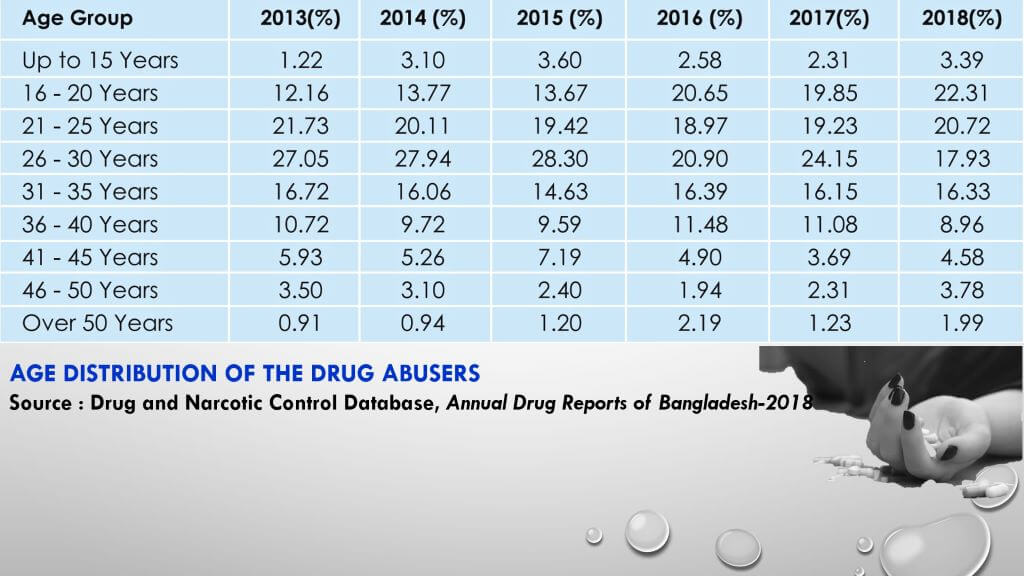
The social effect of drug abuse is also enormous. “It is reported that approximately 70 per cent of crimes including theft, robbery, kidnapping and murder are directly or indirectly related to drugs”.2 Along with social and psychological harm, it poses a financial burden on the abusers and the families of the abusers. The report finds that the daily average intake of the drug is 2.44 times, ranging up to 5 times. A yaba user has to spend from TK. 1,000 to around TK. 2,000 every day if one has to pay TK. 355 per pill. It is expensive as considered of the higher class.
Every family in the country will not be left from the possible effects of yaba if the state functionaries fail to control the Bangladesh-Myanmar border from smuggling it and abate its use inside the country. The country is in danger of a possible mental health crisis in the near future. It is indeed a ploy to destroy Bangladesh and its potentialities through the spread of yaba-like any other form of drugs, the way imperialistic power did to the Chinese through deliberately spreading opium addiction in the 19th century.
A nation’s potentiality and progressiveness can easily be halted if only one can divert young people’s mind to something destructive like drug addiction—yaba in the current scenario. The current Rohingya Crisis exacerbated the yaba situation as many Rohingyas get involved with drug trafficking. They are the easy victims of local drug traffickers who are paid as much as TK. 10,000 for transporting 5,000 pills to Dhaka.
A study done from July 2013 to June 2014 on 300 drug users attending at the outpatient department of Central Drug Addiction Treatment Centre, Tejgaon, Dhaka, reveals the atrocity of drug use.3
The physiological and psychological impact of drugs is obvious as yaba lands more and more yaba-patients in treatment centres every year.
According to Madok Drrabbo O Nesha Nerodh Sangstha (Manas), in the country, there are about 7 million drug addicts in the country and 16 per cent of them are women. There is a separate rehabilitation centre for female addicts at Ahsania Mission in Dhaka.5
While most of the drug users “onset smoking at the age of 7 years, about 40% initiate consuming drug before 18. To the young, yaba and Cannabis drugs appear to be the drugs of their choice if looked at the consumption pattern. Pressure from peers or classmates, depression, availability of drugs and prolonged sexual ejaculation are appeared to be the major pull factors. A significant number of drug users reported that they are getting drugs through drug-user friends and 46.5% of respondents reported on the providers of drug sellers/paddlers and nearly one-third of the respondents reported on drug suppliers/traffickers.4
Along with the push factors such as classmates, curiosity, imitating parents and easy availability of drugs, the country’s Drug and Narcotic Control Department reports revealing some of the most common reasons behind taking it. It says that 57.04 per cent of drug abusers are influenced by classmates, while 22.9 per cent of intake is just out of curiosity.
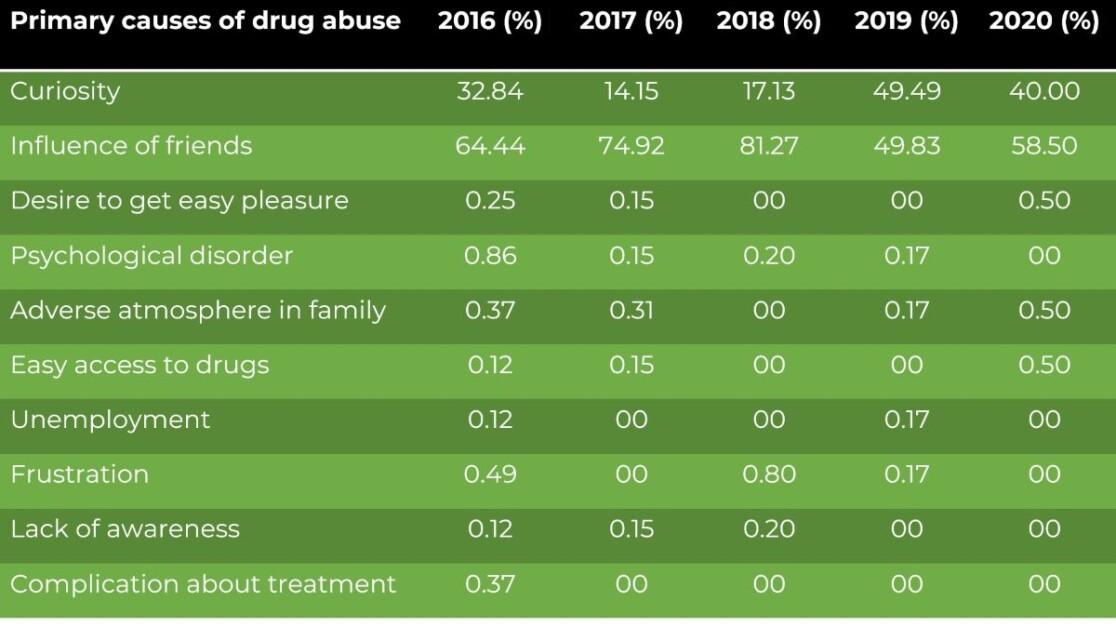
The societal cost of drug abuse is enormous and multifaceted as drug addiction in Bangladesh is linked with crimes that include drug peddling, petty crimes, and road accidents committed under the influence of the drug. Drug addiction has an impact on work. Most of the addicts are unable to work, and students cannot attend their studies.
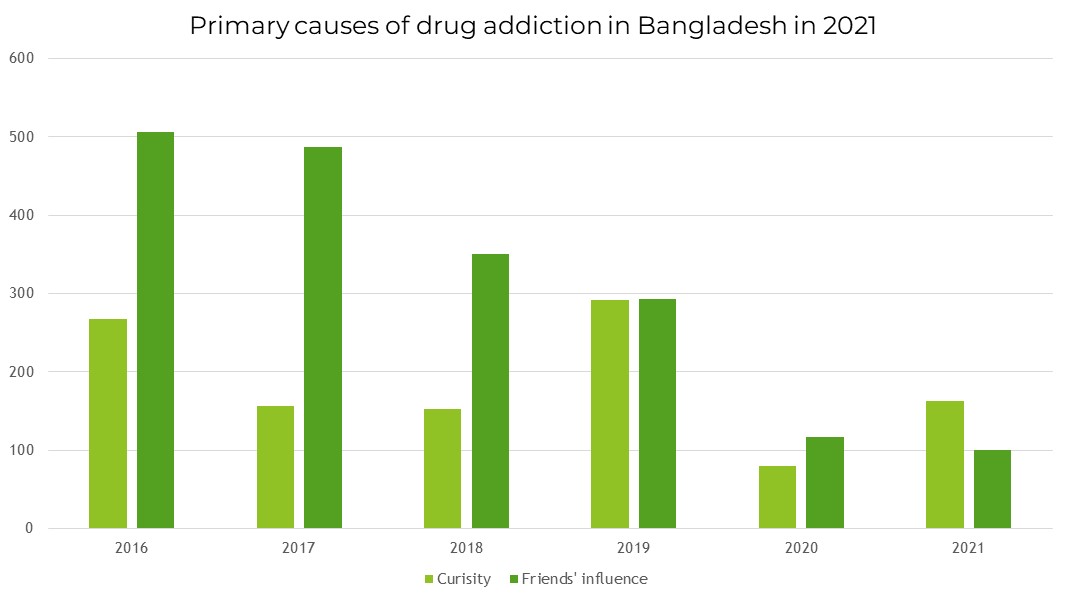
Among drug abusers, intravenous drug use has the potential to turn a slow HIV epidemic into an explosive and devastating one. Adolescents and young adults use the substance for various socio-economic reasons despite knowing the harmful effects of the substance. Family support, controlling easy availability of drugs, treatment of withdrawal symptoms and restoration of social, moral and religious values could be helpful in combating drug 3 addiction.
What is Yaba
It is a mixture of 30% Methamphetamine and 70% caffeine. A popular and increasingly available drug among Asian communities in the United States. Users take it by crushing the tablet into powder, which is snorted, or mixed with a solvent or injected, or hit the tablet on aluminium foil paper and then inhale the vapour from the melting tablet which is familiar as ‘chasing dragon’.
It’s an ATS (an amphetamine-type stimulant). The use of ATS, excluding “ecstasy”, remains widespread globally, and appears to be increasing. In 2011, an estimated 0.7 per cent of the global population aged 15-64, or 33.8 million people, had used ATS in the the preceding year, according to the World Drug Report.
“Amphetamine is ‘A’ class of chemical compounds that includes drugs used for both medical and recreational purposes. Of this class, d-amphetamine and methamphetamine are approved in several countries to treat a variety of disorders, including attention-deficit hyperactive disorder (ADHD), narcolepsy, and obesity. The major rationale for the inclusion of these drugs as ATS is that they are synthetic stimulants.
“Although prevalence estimates are not available from Asia and Africa, experts from these regions continue to report a perceived increase in the use of ATS. While the use of ATS was already a problem in East and South-East Asia, there are reports of increasing diversion of precursor chemicals, as well as increased seizures and manufacture of methamphetamine, combined with an increase in its use.
Drug addiction in Bangladesh
Prevalance of methamphetamine or ATS
Current data from the drug use survey in Pakistan and Bangladesh, for instance, supports this assessment. The use of ATS is emerging in Pakistan and in Bangladesh with an arming rate. High levels of ATS use are reported in Oceania (2.1 per cent in Australia and New Zealand), Central and North America (1.3 per cent each) and Africa (0.9 per cent), while the estimated annual prevalence of ATS use in Asia (0.7 per cent) is comparable with the global average”.6 Bangladeshi Narcotic control department siezed 53 million pieces of yaba or ATS drugs in 2021.
While Methamphetamine or ATS accounts for 19 per cent of global seizure of drugs, and, The largest quantities of ATS seized in 2019 were of methamphetamine, followed by amphetamine and “ecstasy”. From United States, followed by Thailand, Mexico, Burkina Faso, China, Saudi Arabia, Myanmar, Indonesia, Guatemala and the Islamic Republic of Iran has been siezed the largest amount of ATS drugs. After a significant surge in methamphetamine seizures in Mexico in 2010, seizures doubled again from 13 tons to 31 tons, making it the country where the most methamphetamine was seized.
East and South-East Asia also continue to make up a significant share of the global methamphetamine market, with the highest seizures reported from China (10 tons in 2010 to 14 tons in 2011), Indonesia (354 kg to 1 6 tons), Malaysia (920 kg to 1 ton) and Thailand (6 tons to 10 tons).6
“Based on such data, UNODC’s most recent report concluded that markets for methamphetamine are growing faster than for other ATS, fuelled in part by significant increases in East and Southeast Asia, the United States and Mexico in the last five or six years (UNODC 2012)”.7
However, cocaine is not an ATS because it is not manufactured synthetically, although it is classified as a stimulant”.7 “These drugs as well as other amphetamines, methylenedioxyamphetamine (MDA), and methylenedioxymethamphetamine (MDMA) are used recreationally”.7
ATS (particularly methamphetamine) are used to enhance the ability to work, as well as in recreational or social situations. Work requiring stamina, long hours and hard work is closely linked to methamphetamine use for some people, reports Guidance for Community-Based Treatment and Care Services for People Affected by Drug Use and Dependence in the Philippines.
Local names of yaba
Yaba comes with a Thai name yaa-bâa which literally means ‘mad drug’, and Burmese ‘yabha’ or ‘horse drug’ because it was given to a horse to pull the cart up steep hills and during other work that needed enormous strength. In India, it is ‘bhul bhulia’ in the Philippines ‘shabu’, in China ‘maa goo’ or ‘maa gou’ and in Bangladesh, ‘baba’, ‘guti’ ‘laal’, ‘jinish’ khawon’, ‘nashokata’, loppi, ‘gari’, ‘bichi’, ‘chakka‘, ‘bori’ and on.
A CCN report observes, “Yaba became a symbol of smartness, fashion, and aristocracy. Model girls, film heroines, singers, dancers and many of the celebrities became a subject of media reports for abusing Yaba”.8
According to Drug and Narcotics Control, Bangladesh, there are many different versions of yaba and the most common ones available in Bangladesh come in pink, orange and reddish colours.
The origin of yaba
Myanmar is the largest producer of yaba pills. It has a strong presence in Thailand, Laos and China borders which is known as the Golden Triangle. Formerly used by the long-haul bus drivers to stay awake, it came under strict restriction by the Thai government after many horrific long-distance road accidents in 1970.
As a result, yaba production and consumption were curtailed and strongly controlled by the Thai government in the consequent years. And again in 2014, this drug poured into Thailand affecting boys, as young as 13. In turn, this region has seen a 700 per cent increase in the number of people arrested for yaba or Meth, since 2008, according to data from the Narcotic Suppression Bureau. The authorities last year counted more than 33,000 meth-related arrests in the country.
Dangers of drug abuse
World Health Organisation (WHO) describes the drug as, “drug” is used as an equivalent of “psychoactive drug”, which refers to a substance that has the ability to affect mental processes such as an individual’s consciousness, mood or thinking. The term “drug” does not include alcohol and nicotine which are covered by the term “psychoactive substance”.9
“Over the past two decades, excessive illicit ATS drugs like, amphetamine use has become a major global concern. According to data from the United Nations Office on Drugs and Crime in 2011, ATS were used at rates higher than any other drug class with the exception of cannabis”.7
“In many countries, there are no population-based data on the extent of illicit drug use. Since illicit drug use in many countries is subject to severe criminal sanctions, it is likely that a substantial proportion of illicit drug users are unwilling to disclose information about their use, especially to government-sponsored survey takers”.7
In the same vein, worldwide road traffic injuries are the second most common cause of death for persons between 5 and 29 years of age; 90 per cent of those deaths occur in low- to middle-income countries. Among the drug-related traffic deaths, 51% is responsible for Amphetamine type drugs, yaba, for example.
The World Health Organization estimates that 1.35 million people die annually from traffic-related injuries and predicts that, by 2030, traffic accidents will be the fifth leading cause of death. Driving under the influence of drugs or alcohol is a powerful predictor of traffic-related deaths; it becomes particularly risky when the two are combined.
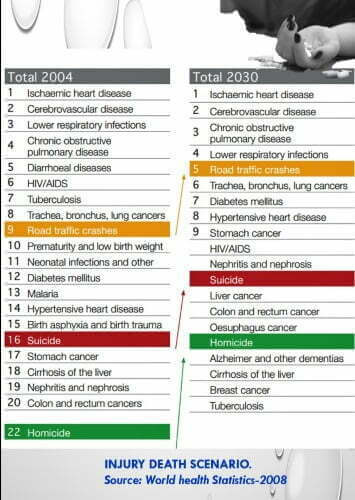
There is growing concern around the world about drug use and road safety. Drinking alcohol and driving is a well-studied risk factor for road traffic crashes, injuries, and deaths but drug-induced impairment of driving is causing increasing concern in many countries around the world.10
World Health Organisation (WHO) summarise that “psychoactive drugs such as Cannabis, amphetamines and Cocaine affect the functioning of the brain and may lead to impaired driving (e.g. by delaying reaction time and information processing, reducing perceptual-motor coordination and motor performance, as well as attention, road tracking and vehicle control). Their effects are Impairment of cognitive functions, motor functions, mood impairment, lateral vehicle control impairment, and time estimation impairment and balance impairment.
For instance, more than one illegal substance can cause impairment: the Transport Research Laboratory study found traces of cannabis, amphetamines, cocaine, methadone and other opiates. If limits were set, they may not capture the complex interactions between drugs and the result on driving: a driver may be severely impaired but under the limit for each drug. Setting a legal limit for use of a substance that is illegal may also seem counter-intuitive.10
Drug addiction is one of the main problems is in the transport sector, in Bangladesh as well, because most of the drivers take yaba while driving. Bangladesh Road Transport Owners Association’s general secretary, Khandakar Enayet Ullah, said they were also very much concerned about drug addiction among transport workers in Bangladesh.
Prevalence of drug use (such as amphetamines, benzodiazepines, cannabis, and cocaine) among fatally injured persons in a road traffic crash ranges from 8.8% to 33.5% (In 2013, illicit drug use was estimated to be responsible for just over 39, 600 road traffic deaths worldwide. Amphetamine use was estimated to cause around half of these deaths while cannabis was estimated to cause one-fifth of them.9
In Cambodia, checkpoints were set up in the area in the northwest of the country in response to a spike in deaths caused by road traffic accidents this summer. Since the beginning of August, nearly 30 people died on the region’s roads, a sharp increase on the 32 that died in the first seven months of the year. After coaches and trucks were stopped and drivers told to take urine tests, officials found traces of drugs in 80 per cent of samples, with “Yaba” or “Yama” – a pill that contains both methamphetamine and caffeine.11
Bangladesh-Philipines connection
After his inauguration in June 2016, in his speeches, the president of the Philippines, Rodrigo Duterte, told the citizens of the country to kill criminals and drug dealers saying, he would command the law enforcement agency to adopt a shoot-to-kill policy and would reward them with bounty money for drug suspects.
The drug war against suspected users, suspected dealers and distributors cost 4251 lives, which is 12,000 plus according to Human Right Watch. According to the Philippines Drug Enforcement Agency (PDEA) From July 1, 2016, to December 31, 2020, the Philippine National Police (PNP) carried out 188,603 anti-drug operations, in which 273,014 suspects were arrested and 6,011 were killed, and 1,262,188 surrendered, at the cost of 83 police officers along with wounded 238.12
Even though Duterte was harshly criticised by rights groups terming the ‘Drug War’ as extra-judicial killing, but was welcomed and lauded by countries like China, Japan, and the United States. China went on as far as to urge other countries to respect Duterte’s anti-narcotic drive.
In Bangladesh, with the arrest of around 1,61,323 peoples by all law enforcement agencies, incarceration of 22,000 and 160 killing of suspected drug dealers, distributors and sellers in just 28 days- as of June 12- after May 15, 2018, Bangladesh’s ‘Duterte-style’ anti-narcotic drive against the drug, most notably yaba (Methamphetamine/Meth) is drawing a huge criticism from many, including some rights groups.
In Bangladesh, Yaba is a class ‘A’ amphetamine drug. According to Drug Control Acts, 2018 ATS drugs such as Amphetamine, Benzfetamine, Lefetamine, Methamphetamine, Methyl Amphetamine, Methamphetamine racemate, Brolamphetamine, DOB, Dexamphetamine, Etilamphetamine, Levamphetamine, Tenamphetamine the nature and quantity of these drugs can one land in prison terms ranging from 1 year to life imprisonment.
“In some countries, the perception of problems associated with the abuse of amphetamine has become so worrisome that even more drastic measures have been taken. Topping the list is Iran, which has a mandatory death penalty for possession of 30 grams of methamphetamine in a regime with extremely harsh penalties for all drug offenses.
Moreover, the executions can be drawn out and extremely painful. In response to reports of precipitous increases in methamphetamine abuse, in 1996 the government of Thailand banned all uses of amphetamine, including those for medical purposes.
Other governments have also taken steps to restrict legal uses of amphetamine, although most have not been as extreme as those taken in Iran and Thailand. For example, in the United Kingdom and New Zealand, while d-amphetamine remains available for medical purposes, any use of methamphetamine (including medical use) has been banned. Recall that d-amphetamine and methamphetamine are essentially the same drugs”.7
In the United States, 69,425 cases filed to Sentencing Commission in Fiscal Year-2018 18964 were drug-related while 39.8% involved methamphetamine abuse. The average sentence for methamphetamine trafficking was 96 months while 98.02% were sentenced to a prison term.13
As for Bangladesh, even though it has declared the war against drugs, the Bangladesh government fails to bring the high-profiled drug lords while petty ones just get killed. Among the arrestees, only 631 were convicted when 911 were acquitted. Corruption and political alignment of high-profile dealers just get scot-free.
Effects of Yaba (methamphetamine)
Chronic doses of methamphetamine (METH) in drug abusers have been associated with increased impulsivity and impairments in learning and attention. In contrast, chronic use of large doses of amphetamine by drug abusers has been associated with adverse behavioural effects, including anxiety problems, mood swings, depression, feelings of paranoia, and panic attacks.
“Drug abuse causes stress in a family, draining of family resources, shrinking from responsibilities, extramarital relations, and distortion of interpersonal family relationships violence, sickness, and death.3
According to DNC, chronic use of yaba results in tremors, hypertension, hallucination, damage to small blood vessels of the brain and heart, psychotic episodes, paranoid delusion, violent behaviour, hyperthermia, convulsion, agitation, anxiety, nervousness, and psychosis similar to schizophrenia. Yaba has the property of development of tolerance leading to a progressive increase in the amount of drug requirement.14
Researchers from the reputed universities of the United States discovered the ominous side-effects of methamphetamine: “This knowledge has raised concerns about the potentially harmful consequences of methamphetamine abuse on the human brain and behaviour. Dopamine-rich areas serve a wide range of important human functions ranging from mood to movement to learning and memory. Indeed, a substantial database collected in laboratory animals suggests that acute and long-term administration of amphetamine produces disruptive effects in several cognitive domains, including learning and memory”.7
If considered the socioeconomic scenario of Bangladesh, a regular user of yaba or ATS drugs has to consider the probable high cost of his addiction. Research shows the consumption of a drug like Yaba is no more elite addiction; it had been permeated from the lowest economic position to the highest economic elite prospect. As a high percentage of consumers from the middle or lower-middle class, many have taken refuge in illicit activities, like mugging, snatching, stealing, street robbery and numerous forms of unlawful activities in order to secure additional costs.
There is no standard diagnostic test and treatment protocol yet. History of drug intake, clinical features supported sometimes by detection of it and its symptoms. The social effect of drug abuse is also enormous. It is reported that approximately 70 per cent of crimes including theft, robbery, kidnapping, and murder are directly or indirectly related to drugs.
The crazy medicine’ called Amphetamine (Yaba) has become the drug of choice among the young generation over the past few years as it is cheap, potent, easy to carry and highly addictive. A densely populated nation of about 160 million people, Bangladesh is now on the front lines of the Yaba epidemic.15
With the increasing quantity of smuggled drugs, more and more people are being involved in the drug business and the country is going to be transformed into potential abuse of drugs with the rapid increase in the number of addicts. Abuse of drugs is a multidimensional problem across the world. Drug abuse directly influences the economic and social aspects of a country.
The disintegration of the old joint family system, the business of the parents, the formation of a nuclear family, the absence of parental love and care in modern families where both parents are working, the decline of religious and moral values etc. also lead to a rise in the number of drug addicts.
People of all sections are gradually being conscious about drug addiction is a disease like many other diseases in our society. The establishment of so many Detoxification Centres in the city of Dhaka and other District Towns indicates that drug addiction in Bangladesh is increasingly being emerged as a public health problem.14
The young generation especially students are being hooked to Yaba and consequently, they are being dropped out from the education system. “Drug addiction in Bangladesh is expanding rapidly among adolescents, street children and school and college-going students recently where youth were the major drug abusing group of the population during the last decade. The slum dwellers especially women, being engaged in carrying and peddling drugs are being a victim of drug addiction”.14
The New York Times 2004 article about the adverse effects of Methamphetamine or METH or yaba titled This Is Your Brain on Meth: A ‘Forest Fire’ of Damage duly reveals it. The article reads “People who do not want to wait for old age to shrink their brains and bring on memory loss now have a quicker alternative — abuse methamphetamine for a decade or so and watch the brain cells vanish into the night–We expected some brain changes but didn’t expect so much tissue to be destroyed”.
Methamphetamine deeply affects a user’s brain and body. These effects are often visible in a number of areas of a meth addict’s life. One of the first signs of methamphetamine abuse is a sudden loss of interest in other areas of life. Hobbies, relationships and career goals will all take a back seat to meth.
Moreover, the United Nations says that almost half a million people were killed by drug use in 2019 while 18 million years of healthy life was lost due to drug use disorder. HIV and Hepatitis C are prevalent among the drug users. In spite of proven harms of drug, its uses persist and even increases.
55 per cent of the deaths attributable to the use of drugs in 2019 were credited to liver cancer, cirrhosis and other chronic liver diseases resulting from hepatitis C. Deaths attributed to drug use disorders accounted for 26 per cent, of which opioid use disorders contributed to 69 per cent, or 88,000 deaths. Roughly 50,000 people died from opioid overdoses in the United States in 2019, more than double the 2010 figure.
Research has shown that urbanization is likely to be one of the many factors that can have an impact on drug use. The positive correlation observed in some studies between urbanization and drug use suggests that the projected global increase in urbanization may lead to a stronger increase by 2030 in the global number of people who use drugs than the increase projected purely on the basis of population growth.
In January, the headquarters prepared a list of 20,000 drug peddlers from across the country. The yaba addicts,16 who are mostly youths, spend a minimum of Tk 1,000 to 2,000 per day to buy Yaba pills. One spends a minimum of Tk30,000 to over Tk45,000 per month on the drug.
Short and long-term effects of yaba
(METHAMPHETAMINE) Methamphetamine (meth) is a highly addictive stimulant that can be smoked, injected, inhaled or taken by mouth, according to the National Institute of Drug Abuse.
Symptoms of short-term meth abuse include: increased attention and decreased fatigue increased activity and wakefulness increased talkativeness decreased appetite euphoria and experiencing a rush increased respiration, rapid/irregular heartbeat, increase blood pressure and hyperthermia.
The following are some symptoms to know if someone is already into Yaba or methamphetamine, by Recovery Village, an addiction rehabilitation centre in America.
Taken over a long period of time, crystal meth can cause severe physical and psychological issues as the short-term effects grow in intensity and complexity.
Signs of long-term crystal meth abuse cause outward signs of ageing in users. Since the drug destroys tissues and blood vessels and hampers the body’s ability to heal, users often develop acne, and the skin takes on a dull look and loses its elasticity.
The teeth can begin to decay and crack, resulting in a condition known as “meth mouth.” One of the most serious long-term side outcomes of crystal meth, however, is sudden death from cardiac arrest or stroke.17
“Both drugs restrict salivary flow leading to xerostomia (dry mouth), one proposed cause of “meth mouth.” Adderall and generic versions are used daily and frequently prescribed – each year they are among the top 100 most prescribed drugs in the United States – yet there are no published reports of unattractiveness or dental problems associated with their use.
The physical changes that occurred in the dramatic depictions of individuals before and after their methamphetamine use are more likely related to poor sleep habits, poor dental hygiene, poor nutrition and dietary practices, and media sensationalism”.7
Methamphetamine deeply affects a user’s brain and body. These effects are often visible in a number of areas of a meth addict’s life. One of the first signs of methamphetamine abuse is a sudden loss of interest in other areas of life. Hobbies, relationships and career goals will all take a back seat to meth.
Methamphetamine alters how meth addicts think and feel and makes procuring the next dose of the drug their most important task. The physical appearance of a person using methamphetamines may provide several key clues:
Skin picking: Methamphetamine addicts are known to obsessively pick at their skin. The marks left by this picking may look similar to an extreme case of acne, often leaving open sores on the face.
Skin crawling: Meth addicts also often complain about having crawling skin, a disorder known as formication.
Tooth decay: Another common sign is tooth loss or tooth decay, referred to as meth mouth.
Hair loss: Due to the lack of nutrients in an addict’s body as well as the dangerous chemicals they ingest, hair breakage frequently occurs as well.
Drug policy
In some countries the law and regulation against any form of the drug are very strict, such as in Malaysia selling drugs can earn someone the death penalty, while someone may be fined and deported only for possessing; in China, one faces forced rehab once caught with the drug; Vietnam award someone execution caught with more than 1.3 pounds worth of heroin; in the worst-case scenario someone may face including the death penalty if caught with opium; along with mandatory rehab.
In Thailand a drug dealer may face the death penalty; one may be landed in prison along with deportation in Dubai; possession or use of alcohol or drug can be punished by flogging, fines, imprisonment or even death; Singapore punishes a drug convict with death; sale of drugs is a punishable crime in Indonesia.
in North Korea, someone may face extremely lengthy in a prison camp for drinking or possessing drugs; drug traffickers are sentenced to death in the Philippines; Costa Rica adopted a drug policy to punish a drug dealer with lengthy imprisonment. The average sentence for methamphetamine trafficking was 96 months while 98.02% were sentenced to the prison term, in the USA.
Lax drug policy, law, and regulation, and the politicisation of involvement make drug peddling and consumption and spreading easier in Bangladesh.
According to the Narcotics Control Acts 1990, narcotics-related criminals are punished in various terms of imprisonment. For ‘A’ category drugs such as heroin, cocaine, pethidine, morphine, and amphetamine criminals are punished 5 to 15 years of imprisonment if the quantity of narcotic item exceeds 6 grams.18 life-term imprisonment is included in the newly passed Narcotics Control Acts 2018.
Because of various loopholes and lack of stricter policy in the existing law suspected drug dealers can get away with any criminal activities through rapid bail right after detention. To address the loopholes in the According to Narcotics Control Acts 1990, the government of Bangladesh has prepared a draft of ‘According to Narcotics Control Acts 201819 in order to award stricter punitive measure to the drug dealers priming the current menace of yaba.
Conclusion
Talk does not cook rice.
~Chinese Proverb
Going by the aforementioned editorial, social, cognitive, and physical effects caused by chemical stimulants like Yaba or methamphetamine or METH, and other forms of drug consumption, peddling and selling are alarmingly growing in Bangladesh. Because of the significant number of people from Cox’sbazar districts are involved in yaba trafficking and peddling, the entire community of people of the district has been stigmatised or termed generally criminals. A situation that has been worsened due to the criminal involvement of Rohingya people.
We may have differing political choices and affiliations, libertarian views of an individual way of leading our lives, democratic polity to practice our rights in a democratic fashion, and right to consume anything as per the enshrined right to ‘freedom of speech’, but no aware citizen of a nation can allow the possible destruction of the nation.
It is the same generations of people that are being on the verge of moral and intellectual collapse, are the generations going to take the responsibilities of our country one day. Imagine a nation that is ruled by a bunch of addicts! What possible social, physical, mental and moral well-being can we possibly expect from them?
Yes, what Duterte did was a gory portrayal of homicide and inhumane to plain sight. But when rule of law is handicapped, justice is a far cry, illicit ways of material richness are always a political component, morality, and honest survival are looked down and lawlessness is a cultivated property, then someone must rise from the ashes like Phoenix in order to restore the from all forms of social malice- either it is President Duterte of the Philippines or Prime Mister Sheikh Hasina in Bangladesh.
English cleric and jurist Henry de Bracton’s maxim rings properly to the current Bangladeshi political ambience. His “that what is otherwise is not lawless is made lawful by necessity”. That, a state is constitutionally responsible to bring back order on the basis of the ‘doctrine of necessity’ which is an extra-legal action by the state functionaries. Maximizing the ‘utility’ of the well-being of the sentient beings those results from the action of individuals for the greater number is ‘Utilitarianism’.
It may be reasonably necessary to destroy other property to form a “fire break” because it is urgently necessary to protect others from harm. If the small in number-but is inevitably insidious drug dealers are awarded capital punishment the interest and well-being of a greater section of law-abiding citizens will be secured undoubtedly.
People are easily beguiled and hypnotised by illicit actions.
Research shows many a number of addicts, and terrorists are influenced by associates, friends or companies or become overcurious about the substances over the time of its availability and existence. People learn to adopt or adapt to some sort of behaviour because of constant exposure and media fanfare which is known as ‘acquired taste’ that we tend to acquire for the sake of predominant peer pressure or constant encounter.
Everyone has an inalienable ‘right to life’, but none has any right to exploit peoples’ ‘freedom of choice’ seeking personal financial gain thereby causing damage to their natural cognitive state. Sympathising for the alleged drug dealers or peddlers fall in the preamble of the ‘Universal Declaration of Human Rights’ that everyone should be treated equally and fairly and in accordance with rule of law, but ‘justifiable homicide’ repel ‘violence with violence’ sometimes.
The state must protect its citizens from possible greater harms by eliminating possible threats as a whole. The precedence of ‘right to life’ should always be provided to the law-abiding citizens, not to the ‘social evils’.
There were, and in fact, there are no leaders, rulers or revolutionists in any country who were and are loved by all undisputedly. Therefore, it is the same people who are implicating Prime Minister Sheikh Hasina, for killing the alleged drug dealers, as ‘extra-judicial killing’, were people who were being critical of her because of the prevalence and ubiquitous of drugs in all spectrums of society.
References:
- Editor. Threat posed by Yaba turns too menacing. The Independent. [Online] August 25, 2015. [Cited: June 6, 2018.]
http://www.theindependentbd.com/home/printnews/13097. ↩ - Yaba’ Addiction-A Rising Concern in Bangladesh. Fattah, S A. 7(2):50, Faridpur : s.n., 2012. ↩
- Psychosocial Illness Among The Drug Abusers Undergoing Detoxification In Dhaka, Bangladesh. Zaman, Bushra, et al. South East Asia Journal Of Public Health. ↩ ↩ ↩
- Ltd., SA Consult International. Cause and Victim of Drug Addiction and Way Forward for Establishment of Adequate Treatment and Rehabilitation Facilities at Private Sector in Bangladesh. Dhaka: Department of Narcotics Control Bangladesh, 2018. ↩ ↩
- Desk, News. Why do BD women turn to drugs? The Asian Age. [Online] July 1, 2017. https://www.dailyasianage.com/news/70744/why-bd-women-turn-to-drugs. ↩
- World Drug Report 2013. Nation, United. New York : UNODC, 2013, Vol. E.13.XI.6). e-ISBN: 978-92-1-056168-6. ↩ ↩
- METHAMPHETAMINE: FACT VS. FICTION AND LESSONS FROM THE CRACK HYSTERIA. Hart, Carl L., Csete, Jaonne and Habibi, Don. s.l. : New York, NY 10032, U.S.A. ↩ ↩ ↩ ↩ ↩ ↩ ↩ ↩
- Thompson, Nathan A. Yaba addiction: The dark side of Bangladesh’s increasing affluence. CNN. [Online] 8 6, 2017. [Cited: 6 6, 2018.]
https://edition.cnn.com/2017/08/05/asia/methamphetamine-yaba bangladesh/index.html. ↩ - The organisation, World Health. Drug use and road safety: a policy brief. Geneva, Switzerland: World Health Organisation, 2016. ↩ ↩
- Morris, Hugh. Eight out of 10 Cambodian coach drivers high on meth, says police chief. The Telegraph. [Online] 9 12, 2016. [Cited: 6 5, 2018.]
https://www.telegraph.co.uk/travel/destinations/asia/cambodia/articles/eight out-of-ten-Cambodian-drivers-high-on-meth-says-police/. ↩ ↩ - Vernon, Duncan. Make drug driving illegal, but prevention is better. New Scientist. [Online] 01 16, 2012. [Cited: 6 5, 2018.]
https://www.newscientist.com/article/dn21359-make-drug-driving-illegal-but prevention-is-better/. ↩ - Editorial. PNP reports on anti-drugs drive. Manila Bulletin. [Online] 12 20, 2017. [Cited: 6 5, 2018.] https://news.mb.com.ph/2017/12/20/pnp-reports-on-anti drugs-drive/ ↩
- Quick Facts: Methamphetamine Trafficking Offenses. THE U.S.SENTENCING COMMISSION-2018 ↩
- (DNC), Department of Norcolias Control. Annual Drug Report of Bangladesh, 2016. Dhaka, Bangladesh: Department of Norcolias Control (DNC), 2016. ↩ ↩ ↩
- Bangladesh, Drug and Narcotic Control. Annual Drug Report of Bangladesh 2018. s.l. : Department of Drug and Narcotic Control Bangladesh, 2018. ↩
- Opinion. From parties to residences: How yaba is spreading like wildfire. Dhaka Tribune. [Online] 3 16, 2018. [Cited: 6 5, 2018.]
https://www.dhakatribune.com/opinion/special/2018/03/16/parties-residences yaba-spreading-like-wildfire/. ↩ - Eric Patterson, MSCP, NCC, LPC. The Effects of Crystal Meth Use. Drugabuse.com. [Online] https://drugabuse.com/library/the-effects-of-crystal-meth-use/. ↩
- THE NARCOTICS CONTROL ACT,1990. Narcotic Drugs and Psychotropic Substances Control. Dhaka: s.n. ↩
- Hasan, Kamrul. Stricter narcotics control law on the cards. Dhaka Tribune. [Online] 4 1, 2018. [Cited: 6 5, 2018.]
https://www.dhakatribune.com/opinion/special/2018/04/01/stricter-narcotics control-law-cards. ↩
